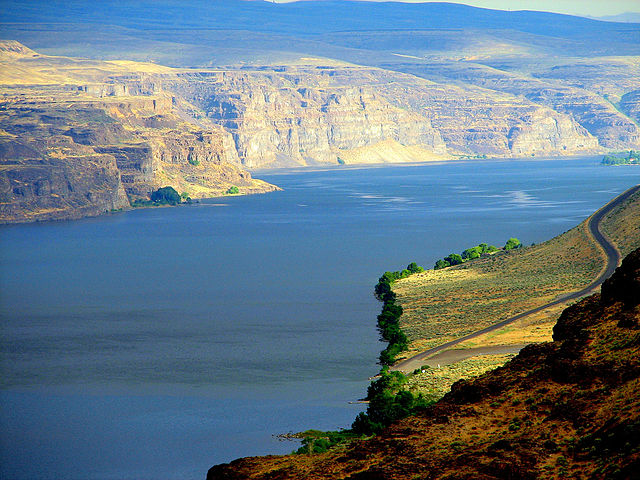Woody Guthrie's Columbia River Songs
by Andrew Boyd
Today, a dam song. The University of Houston's College of Engineering presents this series about the machines that make our civilization run, and the people whose ingenuity created them.
His simple folk tunes have had a lasting impact on such songwriters as Bruce Springsteen and John Mellencamp. He was a social activist who hung with the likes of Bob Dylan and Pete Seeger. And for a time, he sang the praises of damming rivers.
Woody Guthrie was born in Oklahoma in 1914. As a teenager he moved to North Texas, but soon left for California with the waves of people fleeing the great Dust Bowl. From there, he crisscrossed the country, writing and singing songs.

Woody Guthrie, playing his guitar (Al Aumuller/Wikimedia)
At age twenty-seven Guthrie found his way to the Pacific Northwest on the promise of a government job. Here we need to back up about forty years to the passage of the Reclamation Act. Looking west, Congress saw vast areas of fertile land that weren't being cultivated. The problem? Lack of rain. But not lack of water, since great rivers carved their way through the terrain, fed by melting snow. The solution was irrigation facilitated by the construction of dams and ditches. The task fell to the Bureau of Reclamation, which today is the largest wholesaler of water in the U.S. Fully sixty percent of the nation's vegetables are grown with water managed by the Bureau.

The Columbia River and Gorge in Washington State (Jan Tik/Flickr/Wikipedia)

The Orchards near Selah, WA (A. Balet/Wikipedia)
Guthrie came to the Pacific Northwest to make a documentary about the newly constructed Grand Coulee Dam. The dam, located in arid Central Washington on the Columbia River, was the centerpiece of the largest water reclamation project ever undertaken in the U.S. Guthrie never got to narrate the documentary as originally planned, but he was hired to write songs for the soundtrack. For one month he toured a region that he came to call "paradise." Inspired by what he found, Guthrie composed twenty-six songs, including "Grand Coulee Dam" and "Roll on Columbia." His many songs embraced both the beauty of the river and the human capacity to reshape the land. At the time, the Grand Coulee was the largest dam ever built, and it remains the single largest electric power facility of any kind in the U.S.

Banks Lake, Grand Coulee Dam, and Franklin D. Roosevelt Lake (1999 Landsat photo) (NASA/Wikipedia)

A water turbine being assembled at the Grand Coulee Dam (U.S. Bureau of Reclamation/Wikipedia)

Grand Coulee Dam, Interior of Left Powerhouse showing generator room, looking east (John T. "Jet" Lowe/Library of Congress/Wikipedia)
The heyday of water reclamation projects has come and gone. The end of the twentieth century saw the Bureau of Reclamation change its emphasis from construction to maintenance. And for the many benefits of dams and irrigation, we're now more sensitive to the drawbacks as well. Reservoirs change the landscape. Chemicals from irrigation runoff must be dealt with. But for a time our shared national vision was clear; a vision captured in the simple music of Woody Guthrie.
[audio: Woody Guthrie singing Grand Coulee Dam]
I'm Andy Boyd at the University of Houston, where we're interested in the way inventive minds work.
(Theme music)
Notes and references:
The completed government video with Guthrie's soundtrack can be found at: https://archive.org/details/gov.fdr.353.3.4. Accessed July 8, 2014.
G. Bloodworth and J. White. 2008. "The Columbia Basin Project: Seventy-five Years Later." Yearbook of the Association of Pacific Coast Geographers, Vol. 70, pp. 96-111. See also: http://muse.jhu.edu/journals/yearbook_of_the_association_of_pacific_coast_geographers/v070/70.bloodworth.html. Accessed July 8, 2014.
Columbia Basin Project. From the Wikipedia website: https://en.wikipedia.org/wiki/Columbia_Basin_Project. Accessed July 8, 2014.
This episode first aired on July 10, 2014.